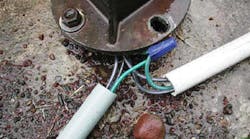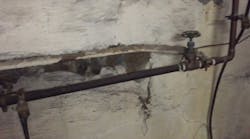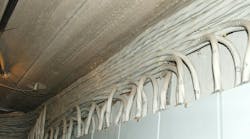As usual, never consider the following commentary associated with these photos as a formal interpretation of the National Electrical Code (NEC). Without criticizing anyone or any product, the following scenarios present us with serious safety questions.
GOT A LIGHT?
This walkway lighting system must have been installed by someone who wasn't familiar with the accepted installation methods. Laying open nonmetallic conduit of this type with energized and exposed supply conductors in this manner doesn't show any knowledge of electrical safety or Code requirements. The proper way to supply this lighting unit would have been to bury underground conduit runs to depths required by 300.5 and extend them into the bottom of the pole where the splices would be accessible. See 410.15(B) for a list of the six requirements you must meet when installing metal poles to support luminaries (lighting fixtures) and serve as a raceway to enclose supply conductors.
PORTABLE POOL PUMP
Harold Endean, a New Jersey electrical inspector, ran across this in-ground pool pump motor wired with an extension cord while performing a final “clean up” inspection of a private residence. As you can see, no permanent connectors were used. An indoor surge suppressor plug strip was also laying next to the pool. The cords were all connected to a single extension cord that was plugged into a receptacle in the backyard at the rear of the house.
According to Art. 400, the extension cord used to supply this short piece of Type NM cable doesn't represent a suitable, or recognized wiring method for this equipment. A storable swimming or wading pool includes those units that are constructed on or above the ground and are capable of holding water to a maximum depth of 42 inches, or a pool with nonmetallic, molded polymeric walls or inflatable fabric walls, regardless of dimension. Art. 680 contains specific rules that must be applied to this installation. See the requirements of 680.1, 680.7, and 680.30. Electrical installations at storable pools shall comply with the provisions of Part I and Part III of Art. 680.
DOWN AND OUT
This common violation can be found around the country. This lighting fixture was installed on a lawn area near the entrance of a hotel. This damage may have been the result of vandalism or a piece of poorly piloted lawn equipment.
The designers of these types of systems need to consider the possible hazards at the installation location and meet the requirements of 410.22, Luminaire (Fixture) Wiring — General, which states, “Wiring on or within fixtures shall be neatly arranged and shall not be exposed to physical damage. Excess wiring shall be avoided. Conductors shall be arranged so that they are not subjected to temperatures above those for which they are rated.”
Found a Code violation? E-mail your photos to Joe Tedesco at [email protected].






